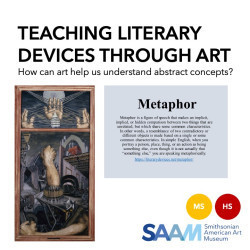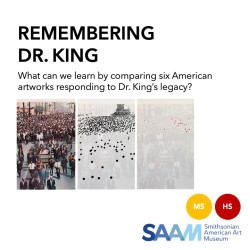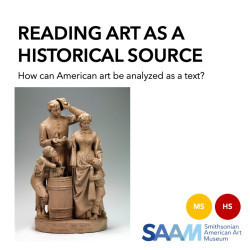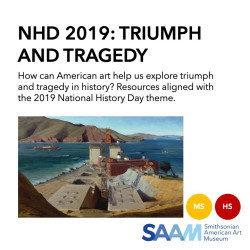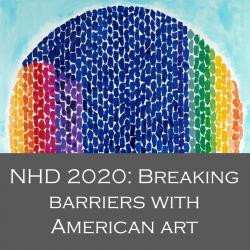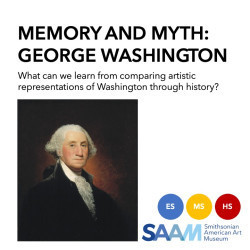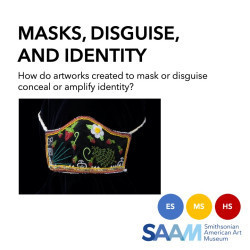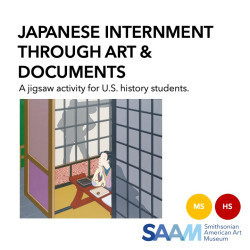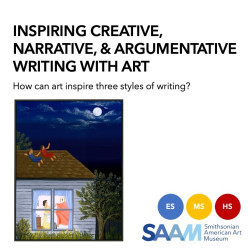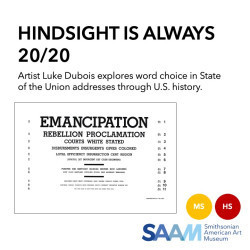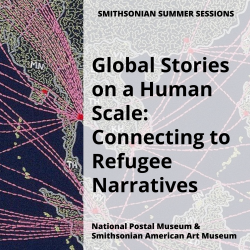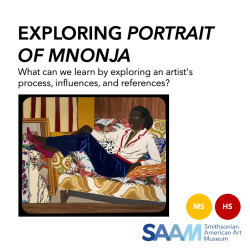Phoebe Hillemann
Teacher Institutes Educator
Smithsonian American Art Museum
As the Teacher Institutes Educator at the Smithsonian American Art Museum, I organize our week-long summer institutes for middle and high school English and social studies teachers: http://americanart.si.edu/institutes. I'm interested in interdisciplinary thinking, arts integration, and the power of dialogue in learning spaces.
Phoebe Hillemann's collections
William H. Johnson's Fighters for Freedom
<p>In the <em>Fighters for Freedom</em> William H. Johnson created a pantheon of historic and contemporary leaders who dedicated their lives to racial justice, individual accomplishment, and social equality. The series features African American abolitionists, scientists, teachers, performers and sports figures, and momentous meetings of allied heads of state.</p>
<p>Collection created to support a session at the 2021 National Council for Social Studies (NCSS) virtual conference.</p>
 Phoebe Hillemann
Phoebe Hillemann
31
Urbanized America: The American Experience in the Classroom
The early years of the twentieth-century saw a significant increase in economic inequality between the wealthiest Americans and the poorest. While the rich continued to bathe in their unregulated, post-industrial age economic success, the poor, largely represented by the overwhelming influx of new immigrants, remained trapped in an unrelenting cycle of poverty and adversity. Many struggled to find prosperity and acceptance in a country where some American citizens harbored foreign resentment and racism. Emblematic of the hardships they encountered is artist Everett Shinn’s chaotic scene of Lower East Side Jewish immigrants being evicted from their homes. This scene in downtown New York City is starkly contrasted with artist Childe Hassam’s romanticized view of an ethereal woman in her uptown home surrounded by beautiful objects likely acquired through European travel. She represents the prosperous post-industrial age, where wealthy patrons demonstrated their cultural sophistication through the acquisition and display of exotic, priceless objects in their homes.<br /><br />
The expanding urban population precipitated the introduction of new building materials in the development of high-rise buildings and tenements, revolutionizing urban living. Technological innovations like the electrified elevator and the Bessemer steel process replaced older building techniques and enabled the construction of high-rise buildings, the new symbols of American progress. However, overcrowding of the evolving urban landscape also gave rise to problems such as poverty, disease, and lawlessness. These issues ultimately led to crucial social reform and legislation, known collectively as Progressivism.<br /><br /><a href="http://americanexperience.si.edu/historical-eras/modern-united-states/pair-eviction-tanagra/">http://americanexperience.si.edu/historical-eras/modern-united-states/pair-eviction-tanagra/</a>
 Phoebe Hillemann
Phoebe Hillemann
21
The Subway
Artworks, photographs, and other documents relating to the New York subway system.
 Phoebe Hillemann
Phoebe Hillemann
8
Remembering Dr. King: Six American Artists Respond
<p>April 4, 2018 marks the 50th anniversary of the assassination of Martin Luther King, Jr. These six artworks from the Smithsonian American Art Museum's collection were created between 1968 and 1996, and respond to Dr. King's legacy in different ways. What does the date of each artwork tell us about the context during which it was made? What can we learn from looking at them as a collection?</p>
<p>Created for a March 1, 2018 webinar for alumni of SAAM's Summer Institutes: Teaching the Humanities through Art. </p>
<p><a href="https://americanart.si.edu/education/k-12/professional-development/summer-institutes" style="background-color:rgb(63,63,63);">https://americanart.si.edu/edu...</a> </p>
<p>#saamteach #martinlutherkingjr #mlk</p>
 Phoebe Hillemann
Phoebe Hillemann
8
Reading American Art as a Historical Source
<p>How can American art be read as a historical text? How can it be used to explore the 2018 National History Day theme of "Conflict and Compromise in History"? This collection examines two works of American art closely, modeling the process of historical inquiry and analysis. It also shares several online resources on reading artwork in a historical context, and suggests additional artworks from SAAM's collection that might support the theme of Conflict and Compromise.</p>
<p>#NHD2018 #NHD</p>
<p>Keywords: Reconstruction, Civil War, John Rogers, Winslow Homer<br></p>
<p><em>#historicalthinking</em></p>
<p><br></p>
 Phoebe Hillemann
Phoebe Hillemann
30
No Spectators: The Art of Burning Man
<p>Each year in Nevada’s Black Rock Desert, a city of more than 70,000 people rises out of the dust for a single week. During that time, enormous experimental art installations are erected and many are ritually burned to the ground. The thriving temporary metropolis known as Burning Man is a hotbed of artistic ingenuity, driving innovation through its principles of radical self-expression, decommodification, communal participation, and reverence for the handmade. Both a cultural movement and an annual event, Burning Man remains one of the most influential phenomenons in contemporary American art and culture.<br /></p>
<p><em>No Spectators: The Art of Burning Man, </em>an exhibition at the Smithsonian's Renwick Gallery, brings the large-scale, participatory work from this desert gathering to the nation’s capital for the first time. This collection features video interviews with many of the artists whose artwork is featured in the show.</p><p><br /></p><p>Keywords: STEM, STEAM, Design Thinking, Installation Art, Public Art</p>
 Phoebe Hillemann
Phoebe Hillemann
17
Native American Art and Artists
<p>The artworks in this collection were made by artists who identify as Native American. What can we learn from the diversity of media and subject matter? How might these works be used to counter stereotypical narratives about American Indians? </p><p>Created for a March 20, 2018 webinar with Montana teachers.</p>
 Phoebe Hillemann
Phoebe Hillemann
17
Memory and Myth: George Washington in American Art
<p>George Washington is one of the most mythologized icons of American history, and one of the most frequently represented figures in American art. What can comparing and contrasting these varying representations tell us about our national understanding of this founding father and first American President? How does the historical context during which an artwork was made affect its subject matter? How does American art influence the way we think of Washington today? </p><p>Created for the National Council for History Education (NCHE) 2018 annual conference.</p>
 Phoebe Hillemann
Phoebe Hillemann
19
Masks, Disguise, and Identity
<p>Explore pieces created to mask or disguise, from Nick Cave's Soundsuits to masks made during the Covid-19 pandemic. How do these works conceal or amplify identity (of the wearer, or the artist)? How do they relate to history and culture? </p>
<p>Resource created for a September 30, 2021 Artful Teaching Moments program led by the Smithsonian American Art Museum.</p>
 Phoebe Hillemann
Phoebe Hillemann
15
Hindsight is Always 20/20
<p>In <em>Hindsight is Always 20/20</em>, Luke DuBois took the State of the Union addresses from each presidency (up through George W. Bush) and sorted them according to word frequency. The artist then printed the most frequently appearing works as an eye chart for each president, with the more frequently used words in larger type at the top of the chart and the less frequently used words toward the bottom. The traditional eye chart includes sixty-six letters; Luke DuBois’s charts substitute sixty-six words. The lists contain words that are not only important for the issues addressed by each president but also give an impression of how language was used at the time. Each of the forty-one presidencies to have State of the Union addresses at the time DuBois created this series (William Henry Harrison and James Garfield died before they could submit a single message to Congress) has its own eye chart. </p>
<p><em>Multiplicity</em>, 2011</p>
 Phoebe Hillemann
Phoebe Hillemann
42
Global Stories on a Human Scale: Connecting to Refugee Narratives
<p>How do we connect students with global issues, such as refugee crises? How do we move from listening and learning to taking action?<br></p>
<p>The resources in this collection were created for a collaborative session organized by the National Postal Museum & Smithsonian American Art Museum during the 2021 Smithsonian Summer Sessions for Teachers: Interrogating the Stories We Tell. </p>
<p>#SummerSessions</p>
 Phoebe Hillemann
Phoebe Hillemann
14
Exploring Multiple Perspectives with American Art
<p>We started by doing a close reading of Walt Whitman's "I Hear America Singing," followed by an analysis of two paintings using Project Zero Thinking Routines:<br></p>
<ol><li><em>Iceman Crucified #4,</em> by Ralph Fasanella, using See, Think, Wonder</li><li><em>Braceros, </em>by Domingo Ulloa, using Step In, Step Out, Step Back</li></ol>
<p>Returning to the poem, consider how different people we identified in the two paintings might react to the poem. Next, choose two perspectives from any of the texts (written or visual) we've looked at, and use the Two Voice Poem template to compare their points of view on work in America.</p>
<p>Reflection Question: What do we gain by considering multiple perspectives on an issue?</p>
<p><em>This collection was created for the 2019 CATE annual convention in Burlingame, California. </em><br></p>
 Phoebe Hillemann
Phoebe Hillemann
7


